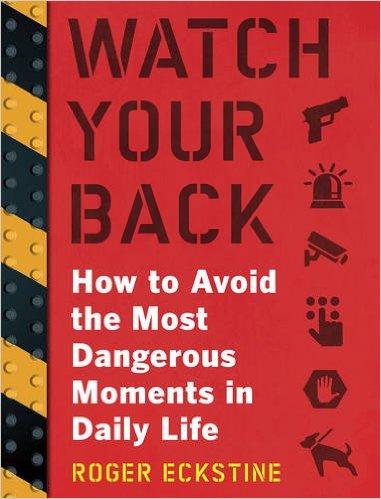Watch Your Back:
How to Avoid the Most Dangerous Moments in Daily Life by Roger Eckstine
by Roger Eckstine
Skyhorse Publishing (Sept. 20, 2016)
ISBN-13: 978-1510702714
8”x10” Paperback, color illustrations, 192 pages
$17.99 paperback; $9.99 Kindle
Reviewed by Gila Hayes
A few weekends ago, I spent an enjoyable, rainy Sunday afternoon reading Roger Eckstein’s Watch Your Back: How to Avoid the Most Dangerous Moments in Daily Life. This book is an unusual treatment of the fundamentals of personal safety, written in an extremely cerebral manner, but then illustrated by real-life strategies. In his opening chapter, the author notes that Watch Your Back picks up and expands into personal defense topics that weren’t germane to his Shooter’s Bible title, Guide to Home Defense. This book’s academic approach is offset with lavish color photos and by examples from many other life pursuits, like safety equipment embraced by race car drivers, for example.
The first step in personal safety, Eckstein asserts, is to preempt the danger entirely. Smart drivers do this daily, he illustrates. To avoid being overwhelmed and failing to act, put preemptive strategies into play one simple step at a time. This also bypasses the aversion some have to acknowledging danger, because each step is small and simple. Among key elements taught, he stresses that in order for preemptive safety steps to be effective, consistent implementation is required and he recommends making precautions a habit, so the reader is ready should self defense become necessary.
Teaching by dissecting specific situations is an interesting strategy and Eckstein uses it well. For example, he details countering the dangers of showing and selling real estate. In addition to spelling out safe ways to meet the prospective buyer, cull out predators before going to a property with them, and safely host open houses, he explains that most predators work by separating the victim from the “herd,” and they make good use of isolation. Protective strategies highlighted are specific to real estate sales work, but the principles have broader applications.
A great majority of Watch Your Back’s instruction deals with safety in and around cars. That’s valuable, in light of how much time most people spend in traffic. Even something as mundane as a stop for fuel presents opportunities for thieves, and Eckstein teaches habits that preempt being the victim. He explains really seeing what is around you instead of just giving a perfunctory scan, and illustrates red flags that recommend driving past one gas station to a safer one. Of course, being able to pick the safest area requires stopping long before the tank is empty, another aspect of preparedness. He outlines streamlining steps like paying at the pump that require close attention, during which your attention to the small read-out screen makes you vulnerable to a surprise attack.
Eckstein commits a considerable number of pages to the mitigating hazards attached to taxi and limo driving, but the lessons are interesting and can be adapted by anyone who uses a car. When he recommends a thorough scan before getting out of the car, he explains, “You must train yourself to comprehend and react to what you see. This means becoming more judgmental.” The driving chapter, like the others, closes with a great synopsis the reader can convert into reminders on which to build new safety habits.
Is it safer to stay in the car or get out at certain venues? Eckstein explores risks assumed when we use conveniences like fast food, drive through banking, dry cleaner pick up and drop off windows, or if we just stop and jump out of the car to drop off mail or a movie, for example. When entering a parking lot, drive around and scrutinize nearby people, “like a suitor asking permission to take your daughter on her first date,” he illustrates. If your first scan doesn’t turn up any red flags, look a second time and concentrate harder, he adds.
Additional chapters discuss handgun selection, safety and accuracy, road rage dangers, fender bender melt-downs, learning to maintain composure and control under threatening circumstances, various degrees of armoring for the vehicle itself, fitting out an emergency bag for vehicle carry, and surviving terrorists or active shooters in “soft target” areas.
Watch Your Back is interesting reading and I took away several lessons that I will implement in my daily life.
To read more of this month's journal, please click here.
